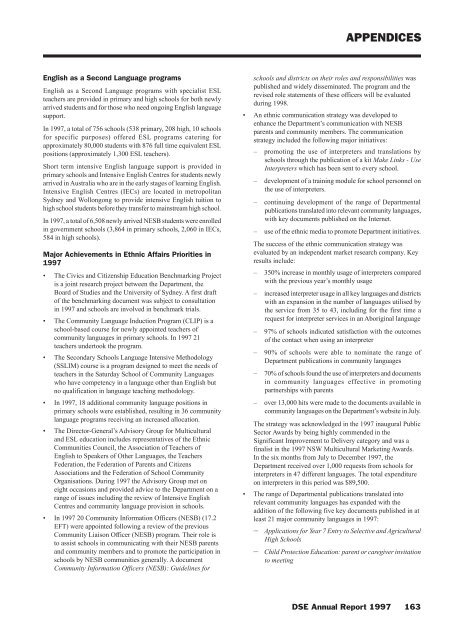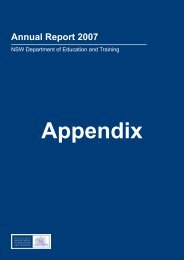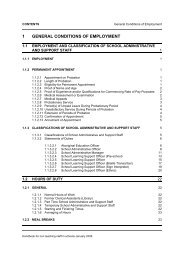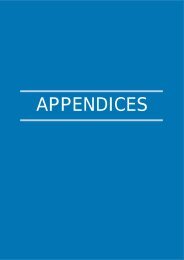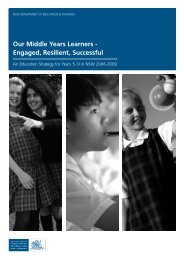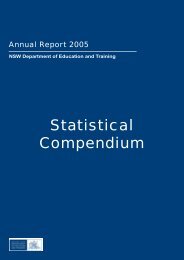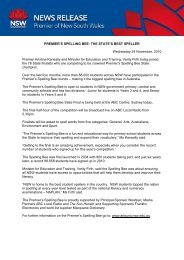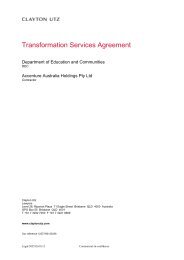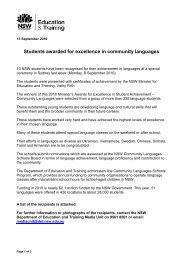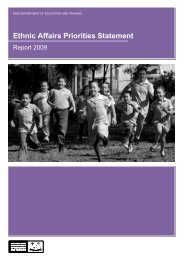01 - Department of Education and Communities - NSW Government
01 - Department of Education and Communities - NSW Government
01 - Department of Education and Communities - NSW Government
You also want an ePaper? Increase the reach of your titles
YUMPU automatically turns print PDFs into web optimized ePapers that Google loves.
APPENDICESEnglish as a Second Language programsEnglish as a Second Language programs with specialist ESLteachers are provided in primary <strong>and</strong> high schools for both newlyarrived students <strong>and</strong> for those who need ongoing English languagesupport.In 1997, a total <strong>of</strong> 756 schools (538 primary, 208 high, 10 schoolsfor specific purposes) <strong>of</strong>fered ESL programs catering forapproximately 80,000 students with 876 full time equivalent ESLpositions (approximately 1,300 ESL teachers).Short term intensive English language support is provided inprimary schools <strong>and</strong> Intensive English Centres for students newlyarrived in Australia who are in the early stages <strong>of</strong> learning English.Intensive English Centres (IECs) are located in metropolitanSydney <strong>and</strong> Wollongong to provide intensive English tuition tohigh school students before they transfer to mainstream high school.In 1997, a total <strong>of</strong> 6,508 newly arrived NESB students were enrolledin government schools (3,864 in primary schools, 2,060 in IECs,584 in high schools).Major Achievements in Ethnic Affairs Priorities in1997• The Civics <strong>and</strong> Citizenship <strong>Education</strong> Benchmarking Projectis a joint research project between the <strong>Department</strong>, theBoard <strong>of</strong> Studies <strong>and</strong> the University <strong>of</strong> Sydney. A first draft<strong>of</strong> the benchmarking document was subject to consultationin 1997 <strong>and</strong> schools are involved in benchmark trials.• The Community Language Induction Program (CLIP) is aschool-based course for newly appointed teachers <strong>of</strong>community languages in primary schools. In 1997 21teachers undertook the program.• The Secondary Schools Language Intensive Methodology(SSLIM) course is a program designed to meet the needs <strong>of</strong>teachers in the Saturday School <strong>of</strong> Community Languageswho have competency in a language other than English butno qualification in language teaching methodology.• In 1997, 18 additional community language positions inprimary schools were established, resulting in 36 communitylanguage programs receiving an increased allocation.• The Director-General’s Advisory Group for Multicultural<strong>and</strong> ESL education includes representatives <strong>of</strong> the Ethnic<strong>Communities</strong> Council, the Association <strong>of</strong> Teachers <strong>of</strong>English to Speakers <strong>of</strong> Other Languages, the TeachersFederation, the Federation <strong>of</strong> Parents <strong>and</strong> CitizensAssociations <strong>and</strong> the Federation <strong>of</strong> School CommunityOrganisations. During 1997 the Advisory Group met oneight occasions <strong>and</strong> provided advice to the <strong>Department</strong> on arange <strong>of</strong> issues including the review <strong>of</strong> Intensive EnglishCentres <strong>and</strong> community language provision in schools.• In 1997 20 Community Information Officers (NESB) (17.2EFT) were appointed following a review <strong>of</strong> the previousCommunity Liaison Officer (NESB) program. Their role isto assist schools in communicating with their NESB parents<strong>and</strong> community members <strong>and</strong> to promote the participation inschools by NESB communities generally. A documentCommunity Information Officers (NESB): Guidelines forschools <strong>and</strong> districts on their roles <strong>and</strong> responsibilities waspublished <strong>and</strong> widely disseminated. The program <strong>and</strong> therevised role statements <strong>of</strong> these <strong>of</strong>ficers will be evaluatedduring 1998.• An ethnic communication strategy was developed toenhance the <strong>Department</strong>’s communication with NESBparents <strong>and</strong> community members. The communicationstrategy included the following major initiatives:– promoting the use <strong>of</strong> interpreters <strong>and</strong> translations byschools through the publication <strong>of</strong> a kit Make Links - UseInterpreters which has been sent to every school.– development <strong>of</strong> a training module for school personnel onthe use <strong>of</strong> interpreters.– continuing development <strong>of</strong> the range <strong>of</strong> <strong>Department</strong>alpublications translated into relevant community languages,with key documents published on the Internet.– use <strong>of</strong> the ethnic media to promote <strong>Department</strong> initiatives.The success <strong>of</strong> the ethnic communication strategy wasevaluated by an independent market research company. Keyresults include:– 350% increase in monthly usage <strong>of</strong> interpreters comparedwith the previous year’s monthly usage– increased interpreter usage in all key languages <strong>and</strong> districtswith an expansion in the number <strong>of</strong> languages utilised bythe service from 35 to 43, including for the first time arequest for interpreter services in an Aboriginal language– 97% <strong>of</strong> schools indicated satisfaction with the outcomes<strong>of</strong> the contact when using an interpreter– 90% <strong>of</strong> schools were able to nominate the range <strong>of</strong><strong>Department</strong> publications in community languages– 70% <strong>of</strong> schools found the use <strong>of</strong> interpreters <strong>and</strong> documentsin community languages effective in promotingpartnerships with parents– over 13,000 hits were made to the documents available incommunity languages on the <strong>Department</strong>’s website in July.The strategy was acknowledged in the 1997 inaugural PublicSector Awards by being highly commended in theSignificant Improvement to Delivery category <strong>and</strong> was afinalist in the 1997 <strong>NSW</strong> Multicultural Marketing Awards.In the six months from July to December 1997, the<strong>Department</strong> received over 1,000 requests from schools forinterpreters in 47 different languages. The total expenditureon interpreters in this period was $89,500.• The range <strong>of</strong> <strong>Department</strong>al publications translated intorelevant community languages has exp<strong>and</strong>ed with theaddition <strong>of</strong> the following five key documents published in atleast 21 major community languages in 1997:– Applications for Year 7 Entry to Selective <strong>and</strong> AgriculturalHigh Schools– Child Protection <strong>Education</strong>: parent or caregiver invitationto meetingDSE Annual Report 1997 163


